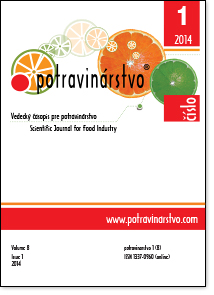Sensory quality, colour and oxidative stability of cured cooked ham with propolis extract
DOI:
https://doi.org/10.5219/365Keywords:
chicken meat, propolis extract, oxidation, colour, sensory qualityAbstract
The effect of 0.06% propolis ethanol extract on the sensory quality, colour and oxidative stability of cured cooked ham was evaluated. Half of the experimentally processed hams treated with 0.06% ethanolic extract of propolis with ascorbic acid (EEP), only with ascorbic acid (AA) and control samples (C) were sliced and vacuum packaged. Samples were kept at 4 °C 21 days (sliced) respectively 20, 50 and 100 days (unsliced). The results revealed that all samples were characterized without any significant colour discrepancies. In general, the thiobarbituric acid value (mg malondialdehyde/kg) increased gradually in all samples examined, with a significantly lower (P <0.05) level for treated samples than for controls. The significantly lowest (P <0.05) sensory parameters in comparison to unsliced hams were observed in sliced hams packaged in vacuum. Sliced hams with EEP were characterized with significantly lowest (P <0.05) intensity of characteristic aroma. Undesirable taste was detected in control sliced hams after storage period. Significantly (P <0.05) more desirable taste of sliced hams was observed in those with only ascorbic acid in comparison with EEP. In our study was demonstrated that 0.06% ethanol extract of propolis positive affected oxidation stability and not negative affected others technological (pH, colour) and sensory characteristics of poultry meat product - cured cooked ham.
Downloads
Metrics
References
Banskota, A. H., Tezuka, Y., Kadota, S. 2001. Recent progress in pharmacological research o propolis. Phytotherapy Research, vol. 15, no. 7, p. 561-571. https://doi.org/10.1002/ptr.1029 PMid:11746834 DOI: https://doi.org/10.1002/ptr.1029
Ali F. H., Kassem G. M., Atta-Alla O. A. 2010. Propolis as a natural decontaminant and antioxidant in fresh oriental sausage. Veterinaria Italiana, vol. 46, no. 2, p. 167-172. PMid:20560126
Garedew, A., Schmolz, E., Lamprecht, I. 2004. Microbiological and calorimetric investigations on the antimicrobial actions of different propolis extracts: an in vitro approach. Thermochimica Acta, vol. 422, p. 115-124. https://doi.org/10.1016/j.tca.2004.05.037 DOI: https://doi.org/10.1016/j.tca.2004.05.037
Gonçalves, G. M. S., Srebernich, S. M., Souza, J. A. M. 2011. Stability and sensory assessment of emulsions containing propolis extract and/or tocopheryl acetate. Brazilian Journal o Pharmaceutical Sciences, vol. 47, p. 585-592. https://doi.org/10.1590/S1984-82502011000300016 DOI: https://doi.org/10.1590/S1984-82502011000300016
Grau, A., Guardiola, F., Boatella, M., Barroeta, A., Codony, R. 2000. Measurement of 2-thiobarbituric acid values in dark chicken meat through derivative spectrophotometry: influence of various parameters. Journal of Agricultural and Food Chemistry, vol. 48, p. 1155-1159. https://doi.org/10.1021/jf990518q PMid:10775365 DOI: https://doi.org/10.1021/jf990518q
Han, S. K., Yamauchi, K., Park, H. K. 2001. Effect of nitrite and propolis preservative on volatile basic nitrogen changes in meat products. Microbios, vol. 105, no. 411, p. 71-75. PMid:11393750
Hunt, M. C., Mancini, R. A. 2002. Guidelines for measuring pork color. In 3rd Annual Pork Quality Improvement Symposium, Michigan State University, 2002, s. 17.
Koo, H., Gomes, B. P. F. A., Rosalem, P. L., Ambrosano, G. M. B., Park, Y. K., Cury, J. A. 2000. In vitro antimicrobial activity of propolis and Arnica montana against oral pathogens. Archives of Oral Biology, vol. 45, no. 2, p. 141-148. PMid:10716618 DOI: https://doi.org/10.1016/S0003-9969(99)00117-X
Ladikos, D., Lougovois, V. 1990. Lipid oxidation in muscle foods: A review. Food Chemistry, vol. 35, no. 4, p. 295-314. https://doi.org/10.1016/0308-8146(90)90019-Z DOI: https://doi.org/10.1016/0308-8146(90)90019-Z
Lu, L. C., Chem, Y. W., Chou, C. C. 2005. Antibacterial activity of propolis against Staphylococcus aureus. International Journal of Food Microbiology, vol. 102, no. 2, p. 213-220. https://doi.org/10.1016/j.ijfoodmicro.2004.12.017 PMid:15992620 DOI: https://doi.org/10.1016/j.ijfoodmicro.2004.12.017
Río, E., Panizo-Morán, M., Prieto, M., Alonso-Calleja, C., Capita, R., 2007. Effect of various chemical decontamination treatments on natural microflora and sensory characteristics of poultry. International Journal of Food Microbiology, vol. 115, no. 3, p. 268-280. https://doi.org/10.1016/j.ijfoodmicro.2006.10.048 PMid:17320231 DOI: https://doi.org/10.1016/j.ijfoodmicro.2006.10.048
Ruberto, G., Baratta, M. T. 1999. Antioxidant activity of selected essential oil components in two lipid model systems. Food Chemistry, vol. 69, no 2, p. 167-174. https://doi.org/10.1016/S0308-8146(99)00247-2 DOI: https://doi.org/10.1016/S0308-8146(99)00247-2
Shahidi, S., Wanasundara, B. K. 1992. Phenolic antioxidants. Critical Reviews in Food Science and Nutrition, vol. 32, no. 1, p. 67-103. https://doi.org/10.1080/10408399209527581 PMid:1290586 DOI: https://doi.org/10.1080/10408399209527581
Shalmany, S. K., Shivazad, M. 2006. The effect of diet propolis supplementation on ross broiler chicks performance. Journal of Poultry Science, vol. 5, no. 1, p. 84-88. https://doi.org/10.3923/ijps.2006.84.88 DOI: https://doi.org/10.3923/ijps.2006.84.88
Šulcerová, H., Mihok, M., Jůzl, M., Haščík, P. 2011. Effect of addition of pollen and propolis to feeding mixtures during the production of broiler chickens ross 308 to the colour of thigh and breast muscle and pH determination. Acta Universitatis Agriculturae et Silviculturae Mendelianae Brunensis, vol. 59, p. 359-366. https://doi.org/10.11118/actaun201159060359 DOI: https://doi.org/10.11118/actaun201159060359
Trusheva, B., Popova, M., Bankova, V., Simova, S., Marcucci, M. C., Miorin, P. L., Da Rocha Pasin, F., Tsvetkova, I. 2006. Bioactive constituents of Brazilian red propolis. Evidence-based Complementary and Alternative Medicine, vol. 3, no. 2, p. 249-254. https://doi.org/10.1093/ecam/nel006 PMid:16786055 DOI: https://doi.org/10.1093/ecam/nel006
Valle, M. L. 2000. Quantitative determination of antibacterial capacities of propolis. Apiacta, vol. 35, no. 2, p. 152-161.
Walker, P., Crane, E. 1987. Constituents of propolis. Apidologie, vol. 18, no. 4, p. 327-334. https://doi.org/10.1051/apido:19870404 DOI: https://doi.org/10.1051/apido:19870404
Wong, J. W., Hashimoto, K., Shibamoto, T. 1995. Antioxidant activities of rosemary and sage extracts and vitamin E in a model meat system. Journal of Agricultural and Food Chemistry, vol. 43, p. 2707-2712. https://doi.org/10.1021/jf00058a029 DOI: https://doi.org/10.1021/jf00058a029
Yang C., Luo, L., Zhang, H., Yang, X., Lv, Y., Song, H. 2010. Common aroma-active components of propolis from 23 regions of China. Journal of the Science of Food and Agriculture, vol. 90, no. 7, p. 1268-1282. https://doi.org/10.1002/jsfa.3969 PMid:20394010 DOI: https://doi.org/10.1002/jsfa.3969
Downloads
Published
How to Cite
Issue
Section
License
This license permits non-commercial re-use, distribution, and reproduction in any medium, provided the original work is properly cited, and is not altered, transformed, or built upon in any way.






























